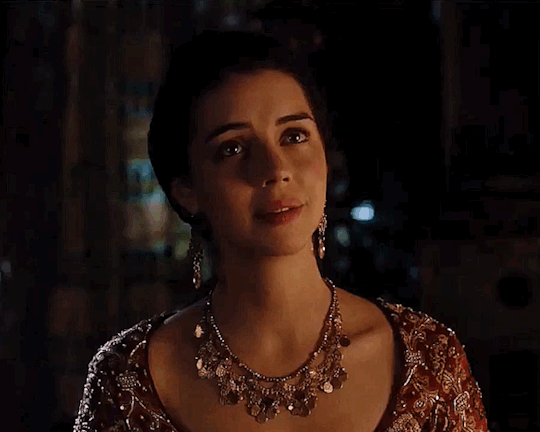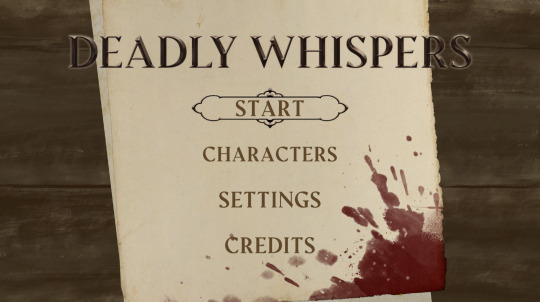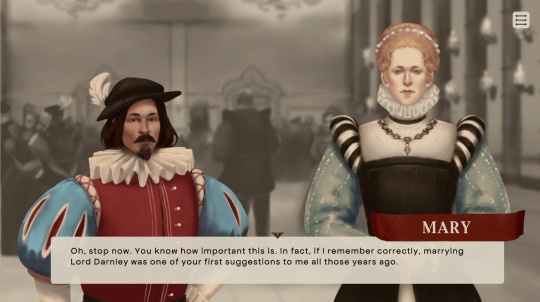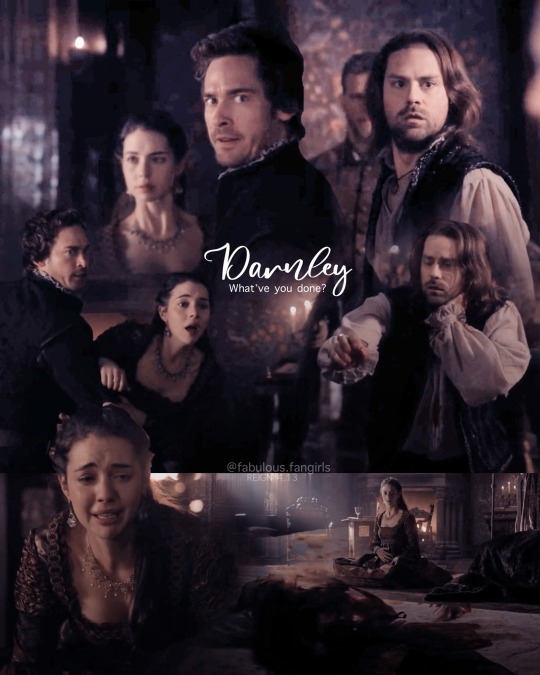#david rizzio
Explore tagged Tumblr posts
Photo

Ismael Cruz Cordova as David Rizzio in Mary, Queen of Scots (Film, 2018).
77 notes
·
View notes
Text








“David? I don’t know how to thank you for all you’ve done for me. With my brother James gone and Greer away. I feel as though I can trust you with my life.”-Mary Stuart
Reign (2013-2017)
#reign#reignedit#mary stuart#david rizzio#marystuartedit#dailyreigngifs#onlyperioddramas#periodedit#period dramas#period drama#perioddramagif#perioddramasource#perioddramagifs#perioddramaedit#tvandfilm#adelaide kane#andrew shaver
82 notes
·
View notes
Text


Participated in my first ever game jam and it was great! It was for the Historically Accurate Game Jam 8, and the theme was assassinations! My team and I created a Visual Novel about a certain famous murder during the rule of Mary Queen of Scots. Check it out!
#deadly whispers#game jam#this was a very intense but also great experience#im proud of how it came out!#we only had ten days#hag8#historically accurate game jam#renaissance clothing is hell to paint#i hate ruffles now#phier#thefailureartist#illustration#game art#visual novel#mary queen of scors#david rizzio#henry stuart#patrick ruthven#william maitland
18 notes
·
View notes
Text
BBC Bloody Queens Elizabeth I and Mary of Scots
Drama reveals the intimate and ultimately deadly relationship between Queen Elizabeth I and Mary, Queen of Scots, using the words of the two queens and their courtiers.


In the beginning, they never met one another in real life for Mary was in France at the time and widowed to returning Scotland. In fact, the only evidence they had was letters. At first, they happily greeted each other and friendship started out. Even friendly called each other sisters. Their childhood and life couldn't be more opposites than ever. However, after many faults, their once friendly letters became hints of jealousy, betrayal, and mystery between the two women began to grow animosity. And question is was Mary innocent? Or did Elizabeth fall for a trap that made her decision to execute her cousin?

Mary was her father's only daughter and became for six days. She grew up with love and luxuries in life. Her days were full of happiness. She went to France to marry Dauphin of France name Francis I son of Henri II and Catherine De Medici. She was the happy yet spoiled princess who grew up believing that she was the heir to England. Sadly she was a widow and was ordered by her mother-in-law to leave France and return to Scotland. Her suffering and test of faith were not over. Scotland became a Protestant country and Mary a well-known Catholic is their queen. It makes the Protestant lords uneasy. Outspokers like John Knox were highly against Mary being queen. For not only being a catholic but she was a woman. Worse, to Scots, she was a foreign woman. A French woman who ruled the hard blood land Scotland. However, Mary had this attitude that she was queen because it was given right from her birth which made her ruler of Scotland. She started to order people around and was a stubborn woman who would say, "No I am the queen and you are my servant." Or "You will have to do as I say goes." As if she was stomping her feet. But Mary wasn't in court without friends. David Rizzio her secretary and Italian courtier also a musician was her favorite and close friend to Mary. Her half-brother was born from her father's mistress, James Stewart, 1st Earl of Moray whom the nobles that converted to protestant even Moray respected him. But Mary's trouble continues the downfall of her quest. Marriage. First, her hand was appointed by Elizabeth I in a deal that she would recognize Mary as her heir if she married a protestant Lord Robert Dudley, 1st Earl of Leicester.

However, Mary was not only insulted but felt anger that Elizabeth would back on their deal. So, Mary decides she needs a catholic, better position to help her claim better for England.

Henry Stuart Lord Darnley, her cousin born from He was the second but eldest surviving son of Matthew Stewart, 4th Earl of Lennox, by his wife Lady Margaret Douglas, which supported his claim to the English succession. Darnley's maternal grandparents were Archibald Douglas, 6th Earl of Angus, and Queen Margaret Tudor, daughter of King Henry VII of England and widow of King James IV of Scotland. Mary fell instantly in love with his good looks and flattery attitude. But noooo. Not him. Anyone but Darnely. For he is not only the grandson of King Henry the Seventh as Mary's blood. But that was Elizabeth's only concern for that. The Scottish lords did not like Darnely because he was the male version of Mary per se. Plus, he was a drinker, vain, spoilt, womanizer, violent temper, and homosexual as well. Mary was in love with Darnely and ignored such "rumors" as she calls them. That is until after marriage with him. he revealed his true colors as Mary was pregnant at the time, but sent letters to Elizabeth to help her. Sadly Elizabeth was advised not to involve a queen's marriage troubles as this was a personal matter. Mary's trouble did not end there. After killing Rizzio for believing that he is the father of her child since she hasn't allowed Darnely near her. Probably fear the risk of miscarriage. That was when Mary took back power and locked Darnely away in his castle where he died in mysterious circumstances. The house exploded, but he survived before being strangled to death. And guess who was the suspect.
James Hepburn, 4th Earl of Bothwell.

Mary is not only widowed the second time, but she marries the possible murder of her husband. Now the lords had no love for Darnley, but his death seemed a bit off as Mary quickly married to Bothwell. Even drew pictures of Mary as a mermaid. Not a compliment mind you. In Scotland, it means whore or seductress. And Mary's reputation went from bad to worse. She rebelled again and this time both Catholics and Protestant lords wanted Mary out of the throne and placed her son James to be king of Scotland and they wanted Moray to be his regent.

Moray had imprisoned Mary and she was separated from both her son and Bothwell who escaped. But the worst is yet to come, Mary had suffered a miscarriage and it was Bothwell's twins. It was horrifying for Mary. They forced her to abdicate either by her vulnerability of losing her miscarriage or threat. Either way, Mary has lost her crown. Mary had strength and a chance to escape. Elizabeth was her thought of helping her get her crown. Wrong again Mary.

Elizabeth was born to Henry VIII and Anne Boleyn. However, her birth was met with scorn by both Catholics and hatred for the Boleyns. However, it was mostly because of the actions her father, mostly her mother had done. he divorced his first wife and married Anne Boleyn to gain a son. Instead, he had a daughter.

She was beloved by her parents, but Anne Boleyn was beheaded under the guise of treason and saw Jane Seymour as his new replacement queen.

Since then her life suffered as now declared bastard or illegitimate as her older sister Mary daughter of Catherine of Aragon the first wife of Henry VIII.

Elizabeth suffered at the hands of her enemies and was accused of treason which included prison during both her siblings' reigns. But she survived it all even treason plots that brought up her name. And never know who to trust.

She never knew peace nor rest for she knows her enemies are lurking to destroy her. She had to play a game that had two chances life and death.
Her greatest enemy is Mary Stuart, Queen of Scots. When Mary had escaped from Scotland and abdication her crown in favor of her son, James. Elizabeth refused to see her cousin as instructed that she must be sent away and be locked up in comfort as her presence endangered Elizabeth's life. Mary was struck with another heat felt like a betrayal again. For Elizabeth hearing about Mary's reputation back in Scotland that gave Elizabeth the decision to never marry seemed like a good idea compared to Mary. Despite Mary's insistent that she is innocent. Mary claimed that she was kidnapped and was raped by Bothwell. That is why she had to marry him to protect her honor.

William Cecil was very loyal to Elizabeth and a firm protestant reformer. He wants Mary dead, but Elizabeth cannot do it. No one would know why. But it could be a reminder of how she lost her mother Anne Boleyn and Katherine Howard who were queens yet executed by the king's pleasure? Or fear of possible invaders who would use Mary's death to dethrone? Either way, Elizabeth would have to be forced as Willaim Cecil found evidence and proof that Mary was part of a coup to take Elizabeth's life and the crown. This angers Elizabeth as she will never go back to the time when she had to suffer at the hands of her enemies and the injustice was ignored. So, two versions said that Elizabeth was pressured by Willaim Cecil and her spymaster Francis Walsingham that there were new plots that were going to break Mary out and have a secret army waiting for her in France or other countries.

Another version said that she did sign it, but changed her mind as she wanted to spare Mary. Though, time was against Elizabeth. It's either her life or Mary's. She cannot have both ways. Mary was tried and found guilty. Then ordered her to be beheaded for treason. Though stories show she made one final defiant as a queen. She wore a red dress a symbol of martyrism. And three times it take to chop her thick neck. The executioner took her head, but her hair was a wig and her head flew off to the side. Finally, her pet dog was hiding under her dress yapping and covered in her blood.

Well, there you go folks the background and queens who were opposite to each other lives. However, tied by fate as they would someday play the role of life and death. The grand prize for the winner was the crown of England which remained with Elizabeth I for the next 44 years after she triumphed over the Spaniard armada and the final enemy who came close to Elizabeth but she remained undefeated.
After her death, the crown did not go to Mary as planned, but it went to her son James Stuart who became the first monarchy to Scotland and England finally united the two kingdoms into the great nation that is today.
#tudors#Stuarts#history#elizabeth i#mary queen of scots#lord darnley#lord Bothwell#David rizzio#Willaim Cecil#Francis Walsingham#anne boleyn#catherine of aragon#mary i of england#henry viii
2 notes
·
View notes
Text

“Darnley what have you done?” | REIGN 4.13
#reign#reign edit#Mary queen of scots#Mary Stuart#Adelaide kane#Marnley#David Rizzio#stupid darnely#SuperSEAL edits
8 notes
·
View notes
Text
Every now and then I will sob over the thought of David Rizzio
Because imagine your best friend's husband sleeps with you.
Your best friend forgives you. You're too close for a man she doesn't even love that much to come between you.
The HUSBAND gets jealous of your friendship with his wife.
He accuses you of sleeping with her and her of cheating on him. Irony, much?
He orders for you to be taken from her
And stabbed
57 times in the room NEXT TO YOUR BEST FRIEND'S BEDROOM
And your body is thrown down the stairs
And stribbed of jewels and clothes.
Like
He was failed, I'm sorry.
He could hardly turn down the king, regardless of his own feelings.
And then the king accuses him of sleeping with the queen, who is like his sister.
And has him brutally murdered in front of her.
#david rizzio#mary queen of scots#scotland#england#lord darnley#history#history era#sad death#betrayal
3 notes
·
View notes
Text
Today David Rizzio died 458 years ago. RIP my dude.
0 notes
Text
Hey ROP fam, did you know that the Mary Queen of Scots film with Saoirse Ronan features Ismael Cruz Córdova as David Rizzio and Jack Lowden as Lord Darnley? Also they're lovers in it? Which I'm guessing must make that whole stabbing-him-to-death thing a bit awkward later on...

(Rubbish screenshot, I know, but it was the best I could get.)
You're welcome. :)
#The Rings of Power#Mary Queen of Scots#Ismael Cruz Córdova#Jack Lowden#Arondir/Mairon crackship is GO
37 notes
·
View notes
Text





The Rings of Power Cast Watchlist ➤ Theme: 📜 Period/Historical 📜 Mary Queen of Scots (2018) directed by Josie Rourke Ismael Cruz-Córdova as David Rizzio
#mary queen of scots#mary queen of scots 2018#ismael cruz cordova#ismael cruz-córdova#josie rourke#rop cast watchlist#a subterranean gif#my gifs#dailyflicks#filmgifs#cinematv#tvfilmsource#tvandfilm
46 notes
·
View notes
Text

George, 5th Lord Seton (About 1531 - 1585) and his Family
Artist: Frans Pourbus the Elder (Netherlandish, 1545-1581)
Date: 1572
Medium: Oil on panel
Collection: National Galleries of Scotland, Edinburgh, Scotland
Description
George Seton is shown here surrounded by his four sons and his daughter. He was a Catholic and a loyal supporter of Mary Queen of Scots, whom he helped to escape from Holyrood Palace after the murder of David Rizzio. Seton was also involved in Mary’s flight from Lochleven Castle, where she had been imprisoned. Following Mary’s escape, Seton acted as her ambassador to the Duke of Alva in the Spanish Netherlands, and it was during this posting in 1572 that this portrait was painted. The figures each have their initials and age inscribed beside them, although it is not certain if these were added by Pourbus or by another hand at a later date.
#portrait#family#half length#lord seton#scottish history#scottish nobility#boys#men#woman#costume#netherlandish art#oil on panel#artwork#fine art#oil painting#frans pourbus the elder#netherlandish painter#european art#16th century painting#national galleries of scotland
17 notes
·
View notes
Text

December 7th *1545 saw the birth of Henry Stewart, Lord Darnley, the Anglo-Scottish aristocrat and second husband of Mary, Queen of Scots.
Darnley was born in 81545 or 1546 at Temple Newsam in Yorkshire, England. The traditional birth date is December 7th, 1545, but some research suggests he was born later.
He was the son of Matthew Stewart, the 4th Earl of Lennox, and Lady Margaret Douglas. His maternal grandparents were Margaret Tudor, the widow of James IV of Scotland, and Archibald Douglas, the 6th Earl of Angus, giving him a line to the Scottish throne, and the English one.
Henry was educated in courtly manners and had the Scottish scholar John Elder as a tutor. and was known for being strong, athletic, and skilled in horsemanship and weaponry. He was also passionate about hunting and hawking, he was brought up aware of his status and had direct family ties to both the Scottish and English kings.
Lord Darnley, was described in many ways, he was, was known for being a charmer and superficially attractive. Henry was arrogant and vain and it's said he was determined to have more royal authority than he had, also was known to be a drunkard who was unreliable and alienated almost everyone, including his wife, he had a charming exterior that hid his true nature. His own biographer called him "a figure of unfulfilled promise".
In February 1565,aged 19 Darnley travelled to Edinburgh and attended the Scottish Queen, dancing a flirtatious galliard with her. Sir James Melville thought him ‘liker a woman than a man’ and ‘beardless and baby-faced’ but Mary described him as ‘the properest and best-proportioned long man that ever she had seen’. They were married at Holyrood chapel on 29th July 1565 and Darnley was proclaimed King of Scotland.
The marriage was unhappy, however, and Mary turned increasingly to her Italian secretary, David Rizzio. A group of disaffected nobles involved Darnley in a plot to kill Rizzio, who was murdered in the presence of the pregnant Queen on 9 March 1566. On 19 June 1566 Mary and Darnley’s son, James, the future James I of England, was born. Towards the end of 1566 Mary and her lords of council met to discuss the ‘Darnley problem’ seeking ‘the means that your majesty shall be quit of him without prejudice to your son’, according to a contemporary record. Early the next year, a group of nobles, led by Lord Bothwell, laid gunpowder in the cellar of his home and blew it up. The bodies of Darnley and his servant were found under a tree in the garden, apparently suffocated while trying to escape. Beside them were a chair, a dagger, a coat, and a cloak. Darnley was 21 years old. He was buried in the vaults of the royal chapel at Holyrood.
Darnley is the taller of the two in this painting, the wee guy is his brother Charles who died aged 19 from consumption four years after his brothers murder.
15 notes
·
View notes
Text
round 1, match 12: the lily of the west vs lord darly


examples & descriptions
the lily of the west
"local man unfairly forced to commit murder because the girl he liked was talking to someone else."
youtube
lord darly
full title (from the original 1579 ballad sheet, a transcript of which can be found here): "a dolefull ditty, or sorowfull sonet of the lord darly, sometime king of scots, neuew to the noble and worthy king henry the eyght and is to be song to the tune of blacke and yellowe"
"a period retelling in verse of one of the most infamous scandals of the 16th century: the murder of david rizzio, musician, courtier, and private secretary to mary, queen of scots and that of her husband henry, lord darnley - very obscure but catchy and underrated!
youtube
24 notes
·
View notes
Text
About Mary&George, there's something really important to understand about king James's attitude.
James VI and I was deepley traumatized because he had a shitty and traumatic childhood, something who affected him for all his life.
The first trauma happened when he wasn't even born!!!
9th march 1566, queen Mary's secretary, the Italian Davide Rizzio ( or Riccio ) was stabbed 57 times by plotters, he tried to save himself hiding behind the queen but it doesn't work.
Mary was deeply traumatized for this not only per sè but for an other motive. She was six moth pregnant and lord Ruthven pointed his sword against his belly and threated to cut her "in pieces". Yes, James was not even born, it was said that he was afraid of swords 'cause this.
when he was 8 months his father was killed, by the man who became his stepfather, his mother was innocent
The 24 april 1567 he saw for the last time his mother, queen Mary Stuart was abducted, imprisoned and raped by james Hepbun lord bothwell. Yes, I know for someone Mary/Bothwell are a very romantic love story but let's be clear. it was a toxic relationship
Two moths later his mother is forced to amrry Bothwell 'cause she's pregnant, with twins, and after a short civil war she's imprisoned by the queen Elizabeth
James is crowned king at 13 months and the regency is on his half uncle, lord James Moray
James Moray was killed in 1570
The the regenty become yhe king's granfather: Matthew Lennox
Matthew Lennox was killed when James was 5, and it's very gory: the consipirator stab him in front of the child, Lennox tried to save himself behind his king, and grandchild but he was taken away by force, then his body, baraly alive, was take near a window and throw away.... ALL OF THIS in front a 5 year child
James was physically abused by his tutor George Buchanan, a puritan fanatic who hates monarchy and beat his pupil nearly every day. James will be one of the most cultured king but he the trauma never left him, one day when he was already king of England he met an old man who looks like Buchanan and he started to tremble.
He said about his tutor "I learned Latin before English", Buchanan also lied about queen Mary's involment in the Darley's death
when he was 13 he met hsi father's cousin, Esmé Stuart and he fall in love with him. Esmé is 39, he's catholic and French so after one year he is forced toi exil but he helps James to start to debunk some things about his mother
when he was 14 he was abucted for an year and nearly killed
It could be end very bad, with James become a psycho but luckly he become a very traumatized man who seek affection from everyone, he came out at 13 so... Esmé, John, Philip, Richard, Robert and then George, he always tried to recreate the relationship between him and Esmé.
and that's all folks
#mary and george#mary & george#tony curran#king james vi#king james vi and i#king james i#james i#james vi#james vi and i
39 notes
·
View notes
Note
I’m sorry if you answered a similar question like this but was there any terrible or traumatic experiences/events King James went through?
Yeah, so, James's life was basically nonstop trauma from the age of negative 3 months to the age of 20.
Unfortunately I don't have a lot of time today but I can come back later and make a post with double-checked dates and links. But just going off of memory here are some highlights (ages may be wrong):
His mother Mary QOS claims a gun was pointed at her belly during the assassination of David Rizzio when she was pregnant with James
His father was murdered, his mother exiled, and he never saw her again after the age of 15 months
As a 1-year-old baby king Scotland fell into a civil war between "his" forces and his mother's
He was raised isolated and lonely in Stirling Castle mostly by grim Presbyterians (not completely locked up alone, but he later spoke of this time as lonely, I rambled about this before, cn: Esmé Stewart) who attempted to brainwash him against Mary QOS (I rambled about this AT LENGTH before)
He was so harshly disciplined/beaten by George Buchanan that he had PTSD symptoms as an adult
He seems to have had developmental problems such as delayed speech and walking, which were probably... not treated sympathetically. He was probably physically disabled though there are dozens of different modern diagnoses that have been offered.
3/4 of his childhood regents were murdered as part of the civil war and/or political feuding. First, his uncle. Then, his grandfather, who was carried bleeding into Stirling castle and died in front of 5 year old James's eyes. Then, the Earl of Mar, who was James's custodian/foster-father, was probably poisoned (James=6).
When James was 11, one of his childhood friends (who was then 20 - he was a bit older than James), pushed by the then-regent Morton, led an armed attack on Stirling Castle to try to take custody of James by force. The Master of Mar, father of his other childhood friend (Thomas Erskine, same age as James) had to take up a halberd and physically protect James from the attackers. James at one point thought the Master of Mar had been killed in front of his eyes. He wasn't, but Thomas Erskine's older brother really was killed.
When James is 13 he looks around at this shitty situation and says "nope", proclaims himself an adult ruler, meets and then immediately falls in love with his 37-year-old cousin Esmé Stewart. (The main subject of this earlier ramble) Probably not good for James's emotional development.
When James is 15 he executes the last of his childhood regents, Morton, probably convinced by Esmé Stewart that the guy had a hand in the murder of his father Lord Darnley. So 4/4 of James VI's regents met sticky ends.
When James is 16 his anti-Catholic nobles, who hate Esmé Stewart, kidnap James and hold him hostage, treating him badly. Esmé Stewart has to flee Scotland and dies in France and James never really recovers from this.
When James is 17 he escapes and rules surrounded by various allies including Catholic nobles. When James is 19 though the kidnappers from before come back to Scotland funded by Elizabeth and take over again.
I think I've forgotten some incidents, like I think he might have almost died once already by this point, but I don't remember the details.
After this point, though, James actually is an adult ruler who can hold his own in politics. So, like, wild backstabbings, betrayals by loved ones, war, etc., but James was more effectively able to ride the political waves and gave as good as he got, so it's not the same level of "helpless kid bashed around by politics".
So......... yeah. A bit of trauma. It's really no wonder he turned out like he did in a lot of ways.
#james vi and i#james's weird stan rambles again#james's trauma conga#no royals really had happy childhoods but james REALLY stands out#content note#tw child abuse#tw csa#tw grooming#tw death#tw trauma#tw murder#probably more but i can't think of them
7 notes
·
View notes
Text
writing fanfic is fun
writing original is asking yourself at three in the morning where the evening went and what's going on with the tab of David Rizzio
2 notes
·
View notes
Text
Books of 2024
The Battle Cry of the Tiger Teachers by Katharine Birbalsingh
The Power of Culture by Katharine Birbalsingh
This Is Not America by Tomiwa Owolade
Dominion by Tom Holland
Veni Vidi Vici by Peter Jones
Biracial by Remi Adekoya
The End of Race Politics by Coleman Hughes
The Zig Zag Girl by Elly Griffiths
Smoke and Mirrors by Elly Griffiths
The Escape Artist by Jonathan Freedland
Troubled by Rob Henderson
Sourcery by Terry Pratchett
Serpentine by Philip Pullman
The Righteous Mind by Jonathan Haidt
Anna Karenina by Leo Tolstoy
The Damages by Genevieve Scott
In The Woods by Tana French
The Likeness by Tana French
The Searcher by Tana French
Tansy Devoy by Anne Fine
The Hunter by Tana French
Verity by Colleen Hoover
Dopesick by Beth Macy
Hex by Jenni Fagan
Race and Culture by Thomas Sowell
Unruly by David Mitchell
Rizzio by Denise Mina
A Personal Odyssey by Thomas Sowell
Undoctored by Adam Kay
Transsexual Apostate by Debbie Hayton
If Symptoms Persist by Theodore Dalrymple
Spoiled Rotten by Theodore Dalrymple
Battle of the Wills by Anne Fine
An Amazing History Atlas of Scotland by David MacPhail
Penance by Eliza Clark
The Sleeper and the Spindle by Neil Gaiman
The Return of the Native by Thomas Hardy
The Last Anniversary by Liane Moriarty
Men Should Weep by Ena Lamont Stewart
Vinne, The Vegan Vampire by Darren Spink
The Wife Between Us by Greek Hendricks and Sarah Pekkanen
Mary, Queen of Scots: Escape from the Castle by Theresa Breslin
Here One Moment by Liane Moriarty
Faithful Place by Tana French
Broken Harbour by Tana French
Reread
The Hobbit by J R R Tolkien
The Fellowship of the Ring by J R R Tolkien
Mansfield Park by Jane Austen
Persuasion by Jane Austen
Sense and Sensibility by Jane Austen
Emma by Jane Austen
This Is Going To Hurt by Adam Kay
The Secret History by Donna Tartt
The Fifth Elephant by Terry Pratchett
Revenge of the Middle Aged Woman by Elizabeth Buchan
The Second Wife by Elizabeth Buchan
Guards! Guards! by Terry Pratchett
Men At Arms by Terry Pratchett
Feet of Clay by Terry Pratchett
Jingo by Terry Pratchett
Thud by Terry Pratchett
Going Postal by Terry Pratchett
Making Money by Terry Pratchett
The Truth by Terry Pratchett
Gone Girl by Gillian Flynn
0 notes